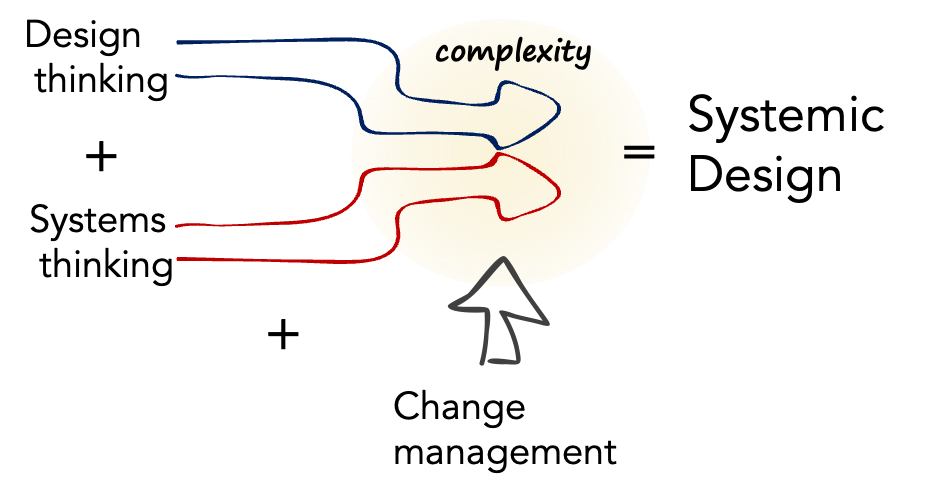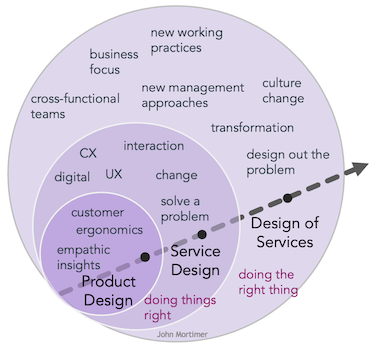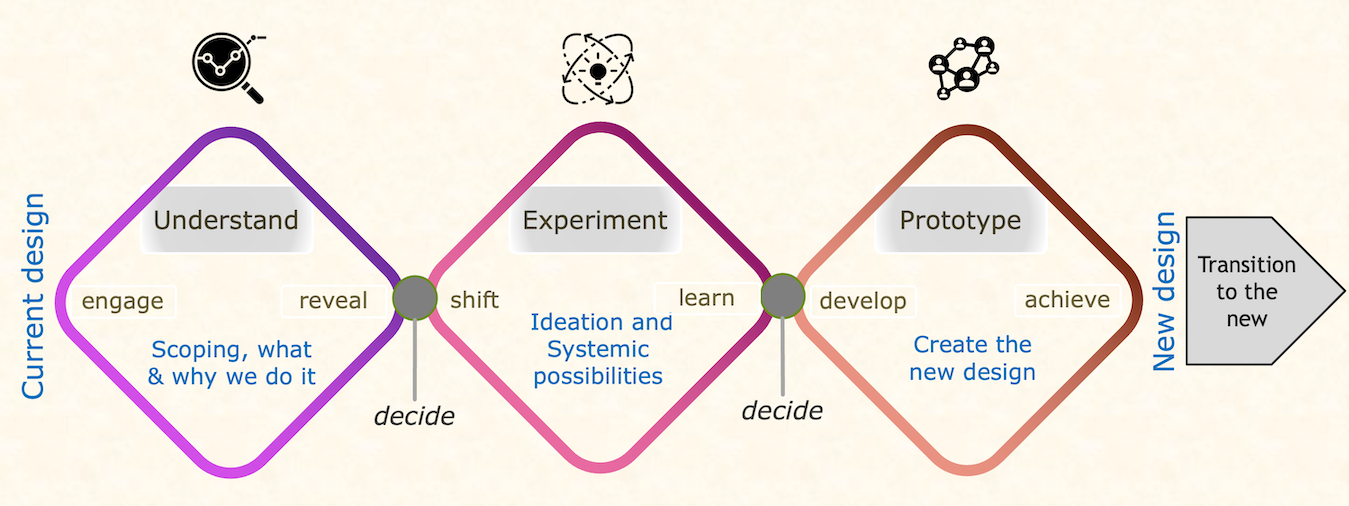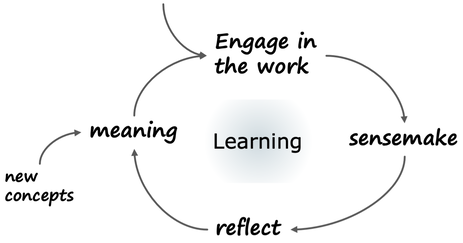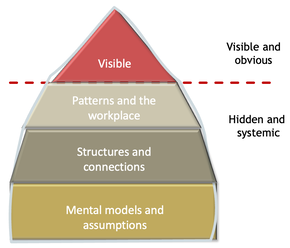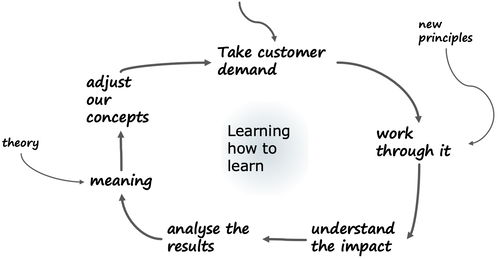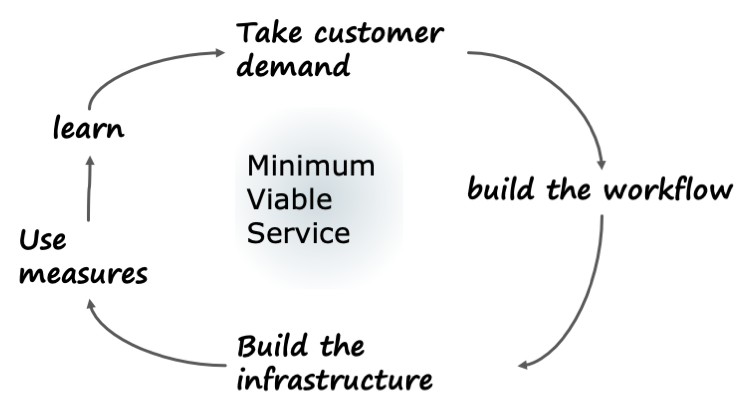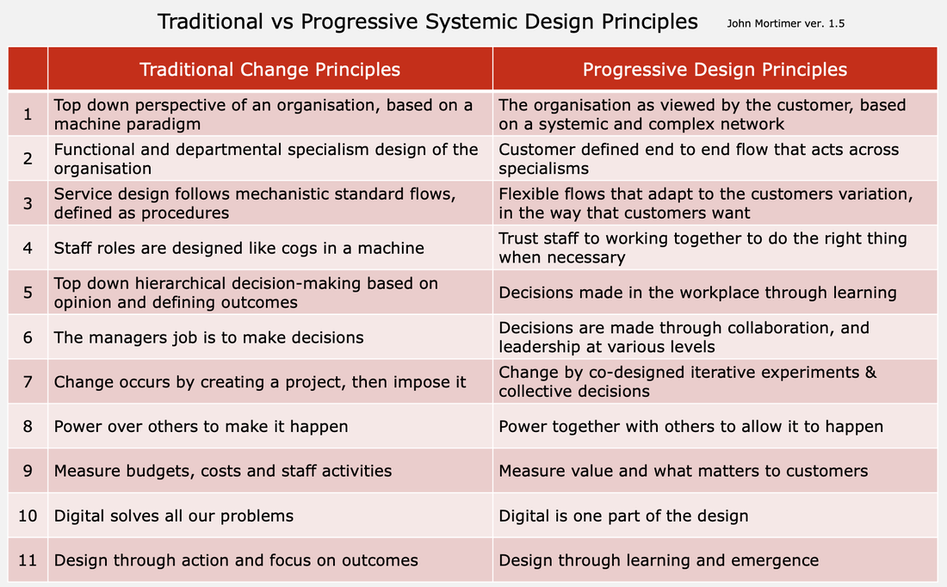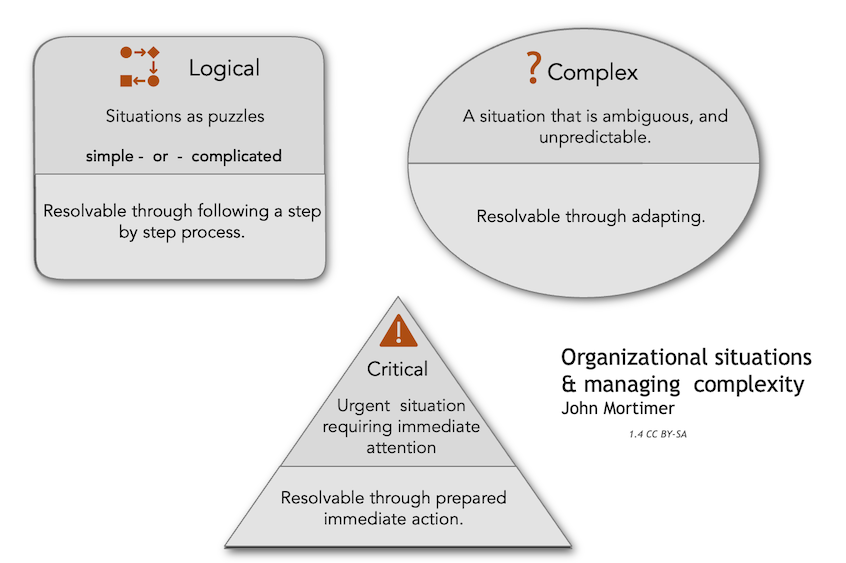Describing the triple diamond framework for the systemic design of services
Part 1. Concepts and methods of the application of systemic design and the diamond framework
Everyone who practices any type of design with an organisation must have some type of method, framework or approach to do what they do. We can take what progressive service, business and organisation designers are already using as a starting point - the design council double diamond framework. Or we can take one of the myriad of design methods out there. We are going to do neither, we will start with the change, systems thinking, intervention theory and design developed to deal with social organisations developed over the past 50 years.
|
Banathys original work created what he called Systems Design, where he developed a methodology that is suited for social systems. This method, in simplified form, was the foundation of the 1996 double diamond framework developed by the design Council of the UK. His work combines systems thinking with design thinking, and recognises that change in complex situations requires particular principles, and a multi-disciplinary approach.
And, there is another aspect to this that we cannot ignore, and that is the inclusion of Change expertise, typically known as change management or Organisational Development (OD). In this write-up, I am going to use the term systemic design to describe all of this. |
There is a general recognition in the service design world and those involved with Change, that we are moving from where it is today, moving closer to transforming more of the whole service itself. Taking UX, project management and the application of digital, to a wider scope involving the staff in co-creation, the culture, and management behaviour. We also strive to move further into the realm of the customers social world. The triple diamond here describes one way of achieving this.
Characteristics of this systemic design approach include;
I am taking this opportunity to reflect and write about the learning that I and many others have gained in the empirical practice of countless interventions using this framework since 2002. And going back to reflect on Banathy's original concepts, this methodology is based on the work of methods developed by John Seddon with the Vanguard Method, and Ibrar Hussain. Ontop of that, we are looking at systemic design that has occurred in the past 80 years. This is why this framework is differs to that developed by the Design Council and their systemic design framework.
Characteristics of this systemic design approach include;
- Design the cause of the problem out of the system. The presenting problem, is almost always not a good place to start.
- Begin from understanding the whole, and understand all the aspects of an organisation and how they interact and influence each other.
- This is about integrating design with other disciplines; business & management, complex change, systems thinking & complexity.
- Moving from product to service. Design the whole operational service as a complex social system, not just implement a digital product.
- Co-design through those in the workplace.
- Co-design directly with the customer.
- Transformation rather than change.
I am taking this opportunity to reflect and write about the learning that I and many others have gained in the empirical practice of countless interventions using this framework since 2002. And going back to reflect on Banathy's original concepts, this methodology is based on the work of methods developed by John Seddon with the Vanguard Method, and Ibrar Hussain. Ontop of that, we are looking at systemic design that has occurred in the past 80 years. This is why this framework is differs to that developed by the Design Council and their systemic design framework.
Systemic Design or Systemic Change, what is it?
The concepts; traditional design vs systemic design.
Traditional approaches reduces the problem to manageable pieces and seeks solutions to each. Practitioners of this approach believe that solving the problem piece by piece ultimately will correct the larger issue this method aims to remedy.
The systemic design approach, in sharp contrast, the seeks to understand a problem situation as a system of interconnected, interdependent, and interacting issues and to create a design as a system of interconnected, interdependent, interacting, and internally consistent solution ideas. Systemic designers envision the entity to be designed as a whole, as one that is designed from the synthesis of the interaction of its parts. A systems view suggests that the essential quality of a part of a system resides in its relationship with, and contribution to, the whole. Systems design requires both coordination and integration. All parts need to be designed interactively, therefore simultaneously. This requires coordination. The requirement of designing for interdependency across all systems levels invites integration.
And now applying this concept to service design;
Traditional approaches reduces the problem to manageable pieces and seeks solutions to each. Practitioners of this approach believe that solving the problem piece by piece ultimately will correct the larger issue this method aims to remedy.
The systemic design approach, in sharp contrast, the seeks to understand a problem situation as a system of interconnected, interdependent, and interacting issues and to create a design as a system of interconnected, interdependent, interacting, and internally consistent solution ideas. Systemic designers envision the entity to be designed as a whole, as one that is designed from the synthesis of the interaction of its parts. A systems view suggests that the essential quality of a part of a system resides in its relationship with, and contribution to, the whole. Systems design requires both coordination and integration. All parts need to be designed interactively, therefore simultaneously. This requires coordination. The requirement of designing for interdependency across all systems levels invites integration.
And now applying this concept to service design;
|
Service Design & Project Change
Deals with the behaviour of customers, focusing on the aspects of the interaction between people who use, and staff who provide a service.
(we tend to focus on customer experience, interactions, and on applying digital technology to enable this) We are focused on designing a specific outcome from the start, often through the innovation of a digital product. |
To
|
Design of Services
Taking the customer needs and characteristics, and designing a service around this, by liberating ourselves from the old methods. We start with the interactions and move into the whole flow of work. Enabling the full human engagement and innovation of staff and managers, through new ways of working together.
We are focused on assisting those in the work to design together, so a whole service reinvention emerges. |
more about the development of designing services
|
Service design
Service design today, as brought through from the world of product design, is generally rooted in the interaction between the customer and the organisation. UX and CX play a central role. As designers, we link these together, to ensure that the organisation has an interface that is ideal for the customers. We create personas to help define the flexibility we need to design in, so that as wide a range of customers can delight in service. |
Designing services
Designing a service is to take an existing service, and to challenge the whole way it works, the way the staff work together through its procedures, and the way that the managers manage. This is starting from the perspective of the customer and the business, and being prepared to challenge the norms, beliefs and mind-set that we currently hold about the way we work. Described as 'meta design' by the Design Council. |
|
This is about developing interfaces, often using Digital. We tend to ask questions like; - What is the problem you want us to solve, and we will solve it? - How can we optimise the experience for the customer, and how can you respond to their needs? - How shall you respond to our design that we come up with? - What is the Digital and other technology that will enable this? - How do we then put this product into the existing service? - How can we leverage technology for you to gain a competitive advance, or simply to keep up. |
This is about redefining the service away from the orthodox, this time starting from asking the question; What would our service look like if everything we do is focused directly only on what we need to do for customers? - What would it look like for the customer? - How should we organise ourselves? - What sort of engagement should we have between all of us? - How should teams work to allow the right sort of decisions to be made at the front line? - How should managers behave to allow the right sort of culture at work that enables freedom for innovative workplaces ? - How can we behave so that individual autonomy, development and a shared focus, allows for each of us to maximise our potential and maximise effectiveness. |
|
As Designers, we begin by being clear on the problem to solve, understanding customers, defining specific outcomes, collaborate with the staff, to come up with excellent products, which we then place into the existing service. Design Thinking puts the human in the center of attention, so we can create the best product and interaction with the staff of the service. |
As Designers, we begin by creating an intervention team, who we develop into undertaking the re-design process. This is led by the leadership team, who then experiment where a new way of working emerges. Design thinking puts the human in the centre of the design of the service, to to create new operations, and allows for a new service to emerge. |
Service design is almost always only dealing with one part of the service. And there is nothing wrong with that. The problem lies when the designer focuses on analysing and re-designing when they are only looking at the customer, or citizen. Looking at them analytically, and using data.
Change methods also often focuses on process, and in contrast to service design, it focuses on the back office processes.
The design of services is about starting with the whole service, and everyone in it. And it is also about the laser-like ability to intervene and reinvent the service - the role of Designer.
Change methods also often focuses on process, and in contrast to service design, it focuses on the back office processes.
The design of services is about starting with the whole service, and everyone in it. And it is also about the laser-like ability to intervene and reinvent the service - the role of Designer.
Background to the double diamond framework and systemic design
The double diamond framework from the Design Council was put together to codify a design process for the new discipline of service design. This design process is rooted in product design. It is generally most used to design print ends - UW and user interaction products. It is based on time based pre-defined logical methods. Taking these as a starting point might be helpful, but remaining with these models will prevent us from delving into greater understanding and development of designing whole services, especially complex ones. We can see this inward focus happening in the disciplines of design and change, when we look at the focus on digital products. This page is to help show that if we go back to examine the work of some of those who developed social and complex change methods, and to add in experience gained in the last two decades, how we can expand on the methods that we are used to.
Banathy created a design approach suited to complex situations, from which this triple diamond is based on. He included concepts from Ackoff - mission or collective purpose, and Checklands root definitions and 'Weltanschauungen' or worldview, and Soft Systems Methodology. This is detailed in Designing Social Systems in a Changing World, which I would recommend for anyone interested in further studying if you are comfortable with technical writing.
Also contributing to this is Ritter and Webber's wicked problems and Ackoff's messes, which guide us to avoid rational problem solving in complex change. Overall the concepts and practice described by Banathy come from a myriad of places of practice of design and innovation through the ages.
This triple diamond framework is based on the method developed by John Seddon; the Vanguard Method which provides a base method specifically for organisations, that is based on pragmatic research and empirical learning. Other names include 'the liberated method'.
Banathy created a design approach suited to complex situations, from which this triple diamond is based on. He included concepts from Ackoff - mission or collective purpose, and Checklands root definitions and 'Weltanschauungen' or worldview, and Soft Systems Methodology. This is detailed in Designing Social Systems in a Changing World, which I would recommend for anyone interested in further studying if you are comfortable with technical writing.
Also contributing to this is Ritter and Webber's wicked problems and Ackoff's messes, which guide us to avoid rational problem solving in complex change. Overall the concepts and practice described by Banathy come from a myriad of places of practice of design and innovation through the ages.
This triple diamond framework is based on the method developed by John Seddon; the Vanguard Method which provides a base method specifically for organisations, that is based on pragmatic research and empirical learning. Other names include 'the liberated method'.
Design is less about being seen as a systematic process, rather than a systemic one.
Social systems are coherent, evolving, interactive processes that have nothing to do with the equilibrium and solidity of technological structures, which are geared to the output of specific processes. Social systems are concerned primarily with renewing and evolving themselves, which are learning and creative processes.
Jantsch
Social systems are coherent, evolving, interactive processes that have nothing to do with the equilibrium and solidity of technological structures, which are geared to the output of specific processes. Social systems are concerned primarily with renewing and evolving themselves, which are learning and creative processes.
Jantsch
The triple diamond framework - how it works
Designing services is about creating different ways of thinking and working. However, the challenge is often not the ideas themselves, but the move from the old to the new. The sequence of working with a service to help them to change can be summarised in the knowledge that underpins this diagram, that takes the original diamond design from Banathy, and several other intervention methods, and develops it into the triple diamond framework, plus one element. This page is written assuming the reader has some prior knowledge of this body of work.
You change things by doing them, not by talking about them.
And why three diamonds? This is because the experiment, or innovation stage is not just about ideas, but about developing new ways of behaving and working that are distinct from that which exists in traditional organisations. And it is important that leaders understand and agree to this becoming part of the prototype, as it affects managers and leaders most of all - as they have to change their mindset and behaviours. If we are simply developing a standalone product, then the double diamond is sufficient. And as the Design Council reminds us; the double diamond was never intended to be just two diamonds, but many, in different configurations
You change things by doing them, not by talking about them.
And why three diamonds? This is because the experiment, or innovation stage is not just about ideas, but about developing new ways of behaving and working that are distinct from that which exists in traditional organisations. And it is important that leaders understand and agree to this becoming part of the prototype, as it affects managers and leaders most of all - as they have to change their mindset and behaviours. If we are simply developing a standalone product, then the double diamond is sufficient. And as the Design Council reminds us; the double diamond was never intended to be just two diamonds, but many, in different configurations
Having a place to innovate that is both removed and connected to the work is important for systemic change, and for having the space to change the way that we work together.
But did you know that any team, any redesign, can achieve this?
What I do is to take a range of front line people from different parts of the services, and we go full time into a room, with the purpose of liberating that team from the constraints of the current organisation.
1. The first thing we do is to examine our current service and how it works, especially the impact on the customer.
2. Then we experiment with a new set of working principles, and learn what is possible. We do this by taking real people through the service.
3. After we have learned how to work and design differently, we create the prototype of the new way of working.
I have achieved this even with a team of by a team of two.
Also part of the team but usually part time, are a senior person - Director or Chief Exec. The service manager, and any experts that we need.
The result - innovative systemic transformation that has been co-designed by those in the work, with those that we call our customers.
But did you know that any team, any redesign, can achieve this?
What I do is to take a range of front line people from different parts of the services, and we go full time into a room, with the purpose of liberating that team from the constraints of the current organisation.
1. The first thing we do is to examine our current service and how it works, especially the impact on the customer.
2. Then we experiment with a new set of working principles, and learn what is possible. We do this by taking real people through the service.
3. After we have learned how to work and design differently, we create the prototype of the new way of working.
I have achieved this even with a team of by a team of two.
Also part of the team but usually part time, are a senior person - Director or Chief Exec. The service manager, and any experts that we need.
The result - innovative systemic transformation that has been co-designed by those in the work, with those that we call our customers.
The elements of the systemic design framework and method
0. The senior leaders realise that their service needs a significant review, and they agree to set up an internal team, who they will work together with, to enquire regarding alternative ways of delivering the service(s) of the organisation.
1. Staff and some each part of the value flow, are brought together to from the redesign team. They work full time, and may include supervisors.
2. The design process begins with the team learning how to sense-make and apply methods to enable innovative experiments to highlight alternative ways of delivering the service.
3. The customer is directly involved in the design; first by sense-making what matters to customers. Then by engaging with individual customers to redesign their individual experience during the Experiment phase
4. The team, together with managers, develop a new collaborative working culture, where each member is valued in their own right. They learn how to work together, evaporating departmental barriers. And they discover what new roles and the level of decision-making the team should have.
5. Managers link up with the team, and learn together with them, creating alternative management behaviours. They gradually increase their role to lead the team in the Prototype stage.
6. Digital and other technology is connected to the team from the start, and they begin their development work when the prototype is being developed.
7. The whole end to end of the service is enabled by bringing in other stakeholders and connecting them into the team. This includes support departments of the organisation; like IT and strategy, as well as groups external to the organisation.
1. Staff and some each part of the value flow, are brought together to from the redesign team. They work full time, and may include supervisors.
2. The design process begins with the team learning how to sense-make and apply methods to enable innovative experiments to highlight alternative ways of delivering the service.
3. The customer is directly involved in the design; first by sense-making what matters to customers. Then by engaging with individual customers to redesign their individual experience during the Experiment phase
4. The team, together with managers, develop a new collaborative working culture, where each member is valued in their own right. They learn how to work together, evaporating departmental barriers. And they discover what new roles and the level of decision-making the team should have.
5. Managers link up with the team, and learn together with them, creating alternative management behaviours. They gradually increase their role to lead the team in the Prototype stage.
6. Digital and other technology is connected to the team from the start, and they begin their development work when the prototype is being developed.
7. The whole end to end of the service is enabled by bringing in other stakeholders and connecting them into the team. This includes support departments of the organisation; like IT and strategy, as well as groups external to the organisation.
We use rich pictures and narratives of how the service currently works. We use story telling for complex cases. Reflective practice. Sensemaking
The design and intervention triple diamond framework in detail
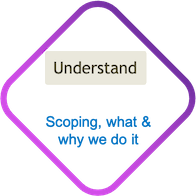
Understand - Why do we need a change? This is about understanding how our current service works from our customers and staff perspective, and being clear on Purpose. And understanding why we have designed it this way, and how well it achieves that Purpose. This then reframes the original problem by defining potential alternative service outcomes.
- understand what we do today and how it impacts customers and staff.
What this physically consists of are demand analysis, value flows, customer needs, staff impacts, measures.
- We also want to understand; why it is like this.
This is about the underlying logic, patterns, structures and paradigms that create the visible elements of the service.
Example - we own many rental properties; The problem - some of our tenants keep failing to pay rent on time, despite the penalties for doing this. We have tried to make it clear in telling tenants how determined we are, and have strengthened the wording in the letters we send out. We make it really easy for them to pay, and we have trained our staff to be polite. The problem still exists!
Understand - We listen to individual tenants, and learn why they are in arrears. We discover that most of them cannot pay on time, and our actions actually make their situation worse. Our way of working is not working for them. We also find that the management believe that enforcing the rules is the best way to achieve this. The outcome of this stage is an understanding that we aspire to design a service suited to the problems non-payers face.
- understand what we do today and how it impacts customers and staff.
What this physically consists of are demand analysis, value flows, customer needs, staff impacts, measures.
- We also want to understand; why it is like this.
This is about the underlying logic, patterns, structures and paradigms that create the visible elements of the service.
Example - we own many rental properties; The problem - some of our tenants keep failing to pay rent on time, despite the penalties for doing this. We have tried to make it clear in telling tenants how determined we are, and have strengthened the wording in the letters we send out. We make it really easy for them to pay, and we have trained our staff to be polite. The problem still exists!
Understand - We listen to individual tenants, and learn why they are in arrears. We discover that most of them cannot pay on time, and our actions actually make their situation worse. Our way of working is not working for them. We also find that the management believe that enforcing the rules is the best way to achieve this. The outcome of this stage is an understanding that we aspire to design a service suited to the problems non-payers face.
more detail
The starting point is a recognition by leaders that the service needs to be redesigned, and they are often clear as to the nature of the problems. However, in this approach of designing a whole service, looking at the service as a system forces us to reframe the original problem; to transcend problems as originally stated into a better future service.
To achieve this reframing, we transcend our current frame of reference that traps us all in our own paradigm. Here, we do this by looking at the service, not from our, but from a customers perspective. Once we perceive this new perspective, the leaders can then decide if they wish to redesign the systemic causes - to effectively design out the reasons for what the problems exists in the first place. The outcome of this stage is a new service paradigm and better outcome.
What we examine are; the operational workflow, waste in the flow, measures, systemic barriers, working culture, staff interactions, management thinking and behaviours.
The enquiries during Understand consists of;
1. What is the Purpose/ Mission of our service from a customers perspective?
2. How well we achieve this purpose.
3. The customer demand into the service, which is the beginning of the reality of customers journeys, through the service, end to end. We listen; sense-making what matters to them.
4. We map out the operational steps within the organisation, and the various departments that they go through.
4. Measure the true value of the service that our customers tell us they get from us compared to the Purpose.
5. Look at the inter-relationships between us, the communication flows, and how they affect our way of working.
6. Examine the role, measures and behaviour of managers and decision-makers in the service, and how these affect the behaviours of what we all do.
7. Link the learning to uncovering the mental models and thinking that underpins the managerial culture.
To achieve this reframing, we transcend our current frame of reference that traps us all in our own paradigm. Here, we do this by looking at the service, not from our, but from a customers perspective. Once we perceive this new perspective, the leaders can then decide if they wish to redesign the systemic causes - to effectively design out the reasons for what the problems exists in the first place. The outcome of this stage is a new service paradigm and better outcome.
What we examine are; the operational workflow, waste in the flow, measures, systemic barriers, working culture, staff interactions, management thinking and behaviours.
The enquiries during Understand consists of;
1. What is the Purpose/ Mission of our service from a customers perspective?
2. How well we achieve this purpose.
3. The customer demand into the service, which is the beginning of the reality of customers journeys, through the service, end to end. We listen; sense-making what matters to them.
4. We map out the operational steps within the organisation, and the various departments that they go through.
4. Measure the true value of the service that our customers tell us they get from us compared to the Purpose.
5. Look at the inter-relationships between us, the communication flows, and how they affect our way of working.
6. Examine the role, measures and behaviour of managers and decision-makers in the service, and how these affect the behaviours of what we all do.
7. Link the learning to uncovering the mental models and thinking that underpins the managerial culture.
We pull together a whole understanding of what our service is really like, and we compare this to how we thought we worked, and to how the customer expects us to work. This then allows us to decide how to proceed to the Experiment.
Concepts
John Seddon, model for Check.
Banathy, the design process and systemic design.
Ackoff and systemic design.
Systems thinking, reframing, iceberg model, SSM, and worldviews.
Argyris & Schon, espoused theories and theories in use.
Theory U, Otto Scharmer.
Norbert Werner, single and double loop learning.
Complexity, to understand sense-making and understanding complexity.
Team working; respect for people from Toyota.
Concepts
John Seddon, model for Check.
Banathy, the design process and systemic design.
Ackoff and systemic design.
Systems thinking, reframing, iceberg model, SSM, and worldviews.
Argyris & Schon, espoused theories and theories in use.
Theory U, Otto Scharmer.
Norbert Werner, single and double loop learning.
Complexity, to understand sense-making and understanding complexity.
Team working; respect for people from Toyota.
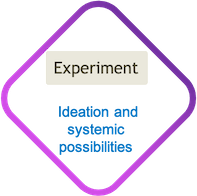
Ideation using Experiments - to learn how to solve the customers demands. Co-designing with the people that use the service, with the staff.
Exploring the desired future by liberating staff from their previous standard methods; exploring new possibilities with a systemic view
It's about innovative disrupting; we block existing aspects of the organisation from us, so a team made up of front line employees develop an alternative systemic design culture, working with customers through active experiments. They do this by taking individual demands from users and learn what happens when we deal with them in new ways. Reflecting, learning and adapting. To develop a new model and paradigm of the new service.
Example; we work with individual non-paying tenants, and understand them, and try out various ways of solving their problem; from threatening them, to simply listening to their life stories. We find that we can indeed improve the non-payment problems, as the % of those we deal with, return back to a position of balance, is far higher than in the old service. We discover five types of situations that cause non-payment, and most of the causes are not in our direct control.
Exploring the desired future by liberating staff from their previous standard methods; exploring new possibilities with a systemic view
It's about innovative disrupting; we block existing aspects of the organisation from us, so a team made up of front line employees develop an alternative systemic design culture, working with customers through active experiments. They do this by taking individual demands from users and learn what happens when we deal with them in new ways. Reflecting, learning and adapting. To develop a new model and paradigm of the new service.
Example; we work with individual non-paying tenants, and understand them, and try out various ways of solving their problem; from threatening them, to simply listening to their life stories. We find that we can indeed improve the non-payment problems, as the % of those we deal with, return back to a position of balance, is far higher than in the old service. We discover five types of situations that cause non-payment, and most of the causes are not in our direct control.
more detail
We liberate ourselves from the standard approach and start with a new set of principles, and work within a protected 'bubble' isolated from the rest of the service;Principles based on working in local government with people who are in need of help:
- Understand what matters for each person, this decides what actions we take together.
- We make decisions based on knowledge and evidence, not opinion or standards.
- Only do what is needed to create value, enabling the person to gain control.
- Take ownership through the end to end journey with the person.
- Work as a team, without department barriers.
- We are here to learn, and improve.
Rule 1 - do not break the law.
Rule 2 - do not make their situation worse.
We start taking a demand, we start by focusing on what matters from each customer and experimenting with solving their issues and provide value. We do this manually using paper to replicate any technology. We repeat this sprint, until we have tried out various ideas and ways of working. The co-creation with customers is achieved by directly working with each of them.
Everything we learn, and do, is put on the visible walls. We discuss lots, and begin to create new workflows.
We focus on what decisions we need to make, and how to do that. If we need expertise, we go outside the team and get it.
- Understand what matters for each person, this decides what actions we take together.
- We make decisions based on knowledge and evidence, not opinion or standards.
- Only do what is needed to create value, enabling the person to gain control.
- Take ownership through the end to end journey with the person.
- Work as a team, without department barriers.
- We are here to learn, and improve.
Rule 1 - do not break the law.
Rule 2 - do not make their situation worse.
We start taking a demand, we start by focusing on what matters from each customer and experimenting with solving their issues and provide value. We do this manually using paper to replicate any technology. We repeat this sprint, until we have tried out various ideas and ways of working. The co-creation with customers is achieved by directly working with each of them.
Everything we learn, and do, is put on the visible walls. We discuss lots, and begin to create new workflows.
We focus on what decisions we need to make, and how to do that. If we need expertise, we go outside the team and get it.
The team develop;
1. A new way of thinking.
2. The ability to model design and systems.
3. Design concepts and principles.
4. The means and method of design and systems thinking.
1. A new way of thinking.
2. The ability to model design and systems.
3. Design concepts and principles.
4. The means and method of design and systems thinking.
When we have learned enough, we pull all our ideas together, to demonstrate the learning we obtained. This is then reviewed and a future prototype design now emerges, which is adjusted to align with the reality of the organisation and its constraints. The team also demonstrate a new way of working, and engaging that will affect the whole organisation structure and culture. It will require new ways of management. Therefore this decision point alloys leaders to understand and lead this change themselves.
Concepts
Senge, Learning as management competence and a design process.
Self exploration of our paradigms, thinking and principles.
Deming, Constancy of purpose.
Team building with a common purpose, in a safe space.
Toyota, iterative continuous improvement as a core way of thinking.
Focus on people as individuals nad the core of the organisation.
Dan Pink, development of roles based on autonomy, mastery, and purpose.
Control with, rather than control over.
Concepts
Senge, Learning as management competence and a design process.
Self exploration of our paradigms, thinking and principles.
Deming, Constancy of purpose.
Team building with a common purpose, in a safe space.
Toyota, iterative continuous improvement as a core way of thinking.
Focus on people as individuals nad the core of the organisation.
Dan Pink, development of roles based on autonomy, mastery, and purpose.
Control with, rather than control over.
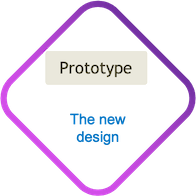
Prototype - From having trialled the new operational workflow, we now expand on this and develop a working Minimum Viable Service;
- model the new service and how it impacts on customers and staff
Here we apply what we learned with the experiments, to create an operational working team, and we design in Digital infrastructure. We do this by taking real demands involving all the stakeholders.
Example; we design a mechanism where we understand the cause of non-payment of the tenant at the earliest point. We then work with them, depending on the cause, to assist them with their issues, possibly using external charities, and the local government for support. We use new measures and find that our non-payment outstanding total value halves with those we tried this with.
- model the new service and how it impacts on customers and staff
Here we apply what we learned with the experiments, to create an operational working team, and we design in Digital infrastructure. We do this by taking real demands involving all the stakeholders.
Example; we design a mechanism where we understand the cause of non-payment of the tenant at the earliest point. We then work with them, depending on the cause, to assist them with their issues, possibly using external charities, and the local government for support. We use new measures and find that our non-payment outstanding total value halves with those we tried this with.
more detail
The prototype builds on the experimentation learning, and we develop a team using the new operational model . And we begin to operate with real customer demands. The operational manager(s) are now firmly in their new role and lead the Prototype forwards.
New measures are created, and these are put to use to learn with the team and managers together.
We develop the new ways of working together and new forms of information flows, that then creates a new working culture. This resembles a cross-functional team that can decide some operational decisions themselves.
Finally, the new forms, Digital infrastructure, and other aspects that are needed for the successful operations are created into the new working prototype.
New measures are created, and these are put to use to learn with the team and managers together.
We develop the new ways of working together and new forms of information flows, that then creates a new working culture. This resembles a cross-functional team that can decide some operational decisions themselves.
Finally, the new forms, Digital infrastructure, and other aspects that are needed for the successful operations are created into the new working prototype.
The result is a small team taking demand in a new way. This is the beginning of the operations of the new service.
Transition - scale to the new service
Transitions the Prototype into; the new service
We make it the normal way of working - by expanding the prototype, finalising digital infrastructure, until it becomes the complete new service. Here we begin to take people from the old service, and pull them carefully into the new team.
Example; We now work with tenants with whatever problems they have, and the team co-locates staff from several departments into there same space . We use visits to tenants as well as phone calls..
We transfer all the staff to this new way of working, and work with stakeholders to develop different working relationships. Over time we monitor the new measures and share this knowledge to all across the system.
Over two years this problem reduces by 70%.
Transitions the Prototype into; the new service
We make it the normal way of working - by expanding the prototype, finalising digital infrastructure, until it becomes the complete new service. Here we begin to take people from the old service, and pull them carefully into the new team.
Example; We now work with tenants with whatever problems they have, and the team co-locates staff from several departments into there same space . We use visits to tenants as well as phone calls..
We transfer all the staff to this new way of working, and work with stakeholders to develop different working relationships. Over time we monitor the new measures and share this knowledge to all across the system.
Over two years this problem reduces by 70%.
more detail
The prototype is complete, and the task is now to develop the redesigned service.
Digital and other infrastructure is developed and completed.
To transfer staff, a member of staff from the 'old' service, is pulled into the new prototype, and they are trained to work in the new way by their colleagues. As staff are added, the size of the old way of working reduces as the new redesign increases.
The original team who were in the prototype will continue to lead to improve the service, and develop a new culture of continuous improvement.
The new measures are fully working, with the service manager now taking full ownership of the service.
The result is a new redesigned service, with a new set of operating principles.
Digital and other infrastructure is developed and completed.
To transfer staff, a member of staff from the 'old' service, is pulled into the new prototype, and they are trained to work in the new way by their colleagues. As staff are added, the size of the old way of working reduces as the new redesign increases.
The original team who were in the prototype will continue to lead to improve the service, and develop a new culture of continuous improvement.
The new measures are fully working, with the service manager now taking full ownership of the service.
The result is a new redesigned service, with a new set of operating principles.
Systemic Design workshop
Find this interesting? How about joining a systemic design masterclass to learn how to apply this
The principles of the systemic design of services & complexity
There are now a whole set of new ways of undertaking systemic change & design, that are quite different from the traditional systematic approaches; where change is manufactured in a room and imposed from above. The new approaches to Change come from alternative sets of fundamental principles. Putting aside the diamond models for a moment; lets look at the universal principles of design that are the underlying laws that cut across the various design approaches.
A version, in the table below, underpins the triple diamond model, and is a more comprehensive way of defining systemic design of services. Understand and follow these principles, and you will be undertaking Systemic change or transformation.
A version, in the table below, underpins the triple diamond model, and is a more comprehensive way of defining systemic design of services. Understand and follow these principles, and you will be undertaking Systemic change or transformation.
As well as principles, complexity is a fundamental factor in how we work together.
You can find more about complexity, design and organisations. organisation-complexity-framework.html
Liberate the method for staff to do the right thing
In the public sector there is a collection of like-minded people, that work this way. We have collected our common concepts into somehtgin called Human Learning Systems
Human - services and organisations are made up of people, who interact, communicate and are themselves complex.
Learning - the design process is based on learning.
Systems - understand the service through a systemic lens.
This approach is not one of simply following a method, it is about allowing people the flexibility to apply way ways of working, with customers and each other. This is similar to 'empowerment' but it is actually far more about 'liberating method' and discarding constraints, so that staff can work in the new way.
Human - services and organisations are made up of people, who interact, communicate and are themselves complex.
Learning - the design process is based on learning.
Systems - understand the service through a systemic lens.
This approach is not one of simply following a method, it is about allowing people the flexibility to apply way ways of working, with customers and each other. This is similar to 'empowerment' but it is actually far more about 'liberating method' and discarding constraints, so that staff can work in the new way.
The fundamentals - what is a good service?
We must know the answer to What is a good service, or what is the point of claiming to design services? This has been a question that has dogged many for decades. However, I find it important to put aside our own opinions, and consider 2 aspects in answer to this question:
- Ask the customer that question - Understanding from the customer drives how we design the flows of the service.
- Explore that question with the people working in the service - Understanding from the staff drives how it works together.
Whatever answers that emerge and what matters to them, will be the foundation of the definition of what the 'measures' should be focusing on.
I would like to define measures here as, not as numbers to be analysed, but the activity of 'how we understand and learn'.
Both areas of measures described above; customer and staff, are then are used to focus the direction of the design of the service.
If you look at the example at the bottom of this page, then you will see this in action.
- Ask the customer that question - Understanding from the customer drives how we design the flows of the service.
- Explore that question with the people working in the service - Understanding from the staff drives how it works together.
Whatever answers that emerge and what matters to them, will be the foundation of the definition of what the 'measures' should be focusing on.
I would like to define measures here as, not as numbers to be analysed, but the activity of 'how we understand and learn'.
Both areas of measures described above; customer and staff, are then are used to focus the direction of the design of the service.
If you look at the example at the bottom of this page, then you will see this in action.
Part 2. The next page describes systemic design in practice, as it applies in the complex reality of designing services

